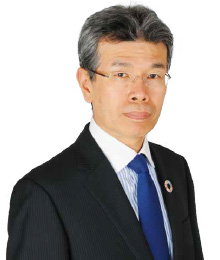
Director, Corporate Officer,
Chief of Environment Division,
Chief of Production Headquarters,
Chief of Safety & Health
Promotion Division


We obtain many resources from the earth—water, food and clothing as well as raw materials such as rubber, resin, and metal. At the same time, we inflict damage on the earth through the emission of greenhouse gases and depletion of resources as a result of overuse in our daily lives and business activities.
Based on the TG 2050 Environmental Challenge, our long-term environmental vision, we formulate action plans every five years to promote environmental protection. These plans have been highly regarded by external organizations, including in corporate rankings by newspapers. To conduct environmental management that meets the expectations of society, we disclose related information in agreement with the recent recommendations of the Task Force on Climate-related Financial Disclosures (TCFD). Going forward, we will continue our efforts to improve corporate culture and human resource development while striving to further strengthen sustainable environmental protection activities.
Contributing to Environmental Preservation Through All Our Business Activities

Basic philosophy
The Toyoda Gosei Group formulated its 1st Environmental Action Plan in 1993 based on its environmental policy, and since that time has been actively confronting environmental issues. In February 2016, we announced our TG 2050 Environmental Challenge, which lays out our long-term goals, and formulated our 6th Environmental Action Plan, which establishes our action items and goals for the five years until 2020. These documents will guide our environmental protection activities moving forward.
To carry out environmental management that meets the expectations of society, we have established environmental operations in the Americas, China, and Asia, and have put in place a global system for area management in these four global regions including Japan. The entire Toyoda Gosei Group will move ahead steadily with a view to 2030, the midpoint of our Environmental Challenge.
1.Environmentally-friendly corporate activities
We are keenly aware that all stages of our business relate deeply to the environment, from development, production, and sales activities to end-of-life disposal. The Toyoda Gosei Group, including all internal departments, domestic and international affiliates, and suppliers, conducts all business activities with concern for the environment in cooperation and coordination with customers, government authorities, and others.
2.Good corporate citizenship
As a good corporate citizen, we participate in, support, and cooperate with environmental activities by many groups while also working on environmental activities in the community and broader society. We also provide education for all employees to support them in becoming involved in environmental activities as members of the community and society, and support social contributions and volunteerism.
3.While spreading information on these activities, we listen to the opinions of people at all levels of society and work to improve our activities wherever we can.
TG 2050 Environmental Challenge —A Greener, Richer World for Our Children
The Toyoda Gosei Group specializes in the field of high polymers—rubber and plastics. Our symbol is the benzene ring, a hexagonal hydrocarbon structure that is the starting point for polymers. Borrowing from the six sides of the benzene ring, the TG 2050 Environmental Challenge sets six challenges to strengthen our environmental efforts with a long-term view to the year 2050.
TG 2050 Environmental Challenge (Six Challenges)
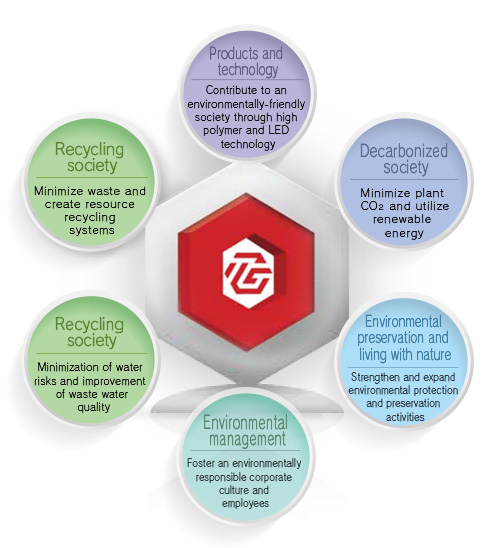
Support for TCFD recommendations
In May 2019, the Toyoda Gosei Group endorsed the recommendations of the Task Force on Climate-related Financial Disclosures (TCFD) and is actively disclosing relevant information together with measures to achieve a decarbonized society, as set forth in the TG 2050 Environmental Challenge (details are posted on our website). In April 2020, we announced our CO2 emission targets for 2030 and are accelerating our efforts.
Efforts to date
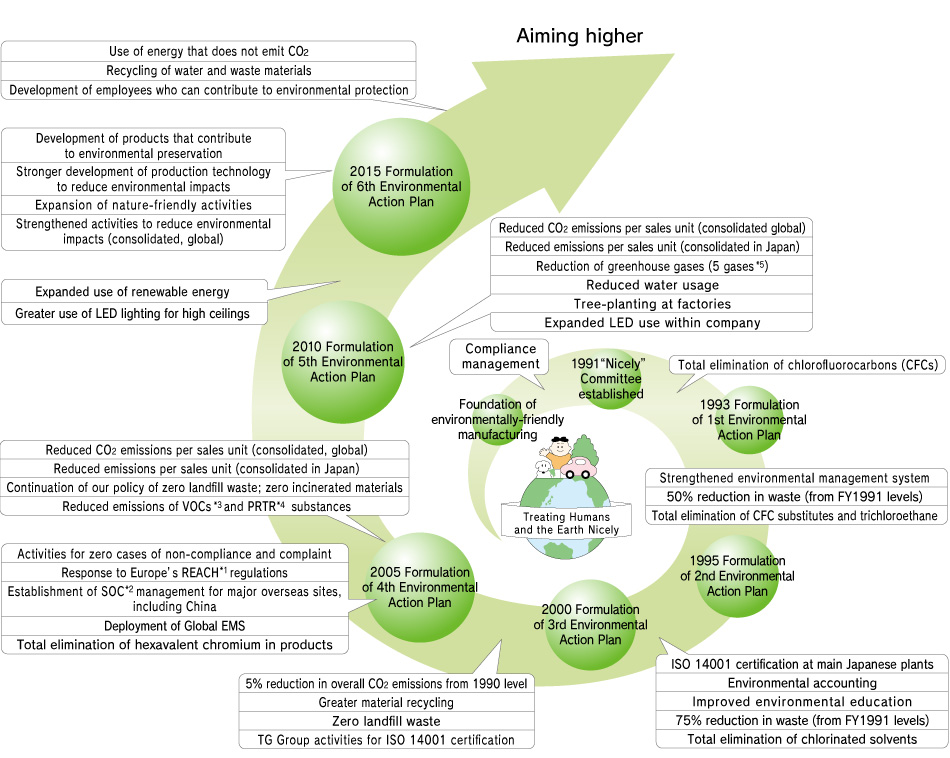
- *1 Registration, Evaluation, Authorization and Restriction of Chemicals
- *2 Substances of Concern
- *3 Volatile organic compounds
- *4 Pollutant Release and Transfer Register
- *5 Hydrofluorocarbons (HFC), perfluorocarbons (PFC), sulfur hexafluoride (SF6), methane (CH4), nitrous oxide (N2O)
Environmental organization
Our medium- and long-term policy and key action items are discussed and decided in an Environmental Committee chaired by the company president. The Environmental Committee consists of four subcommittees in the areas of products, production, and quality. The subcommittees are further broken down into working groups that promote and manage areas such as reductions in energy use, waste products, and volatile organic compound (VOC) emissions, and preservation of the environment. In this way, environmental preservation and management activities are conducted from an expert perspective.
Liaison committees have also been established to share information with related companies in Japan and abroad. Since 2019 we have been strengthening coordination between production technology and plant floor manufacturing (newly established Joint Production and Environment Subcommittee) to promote energy-saving activities.
■Environmental organizational structure
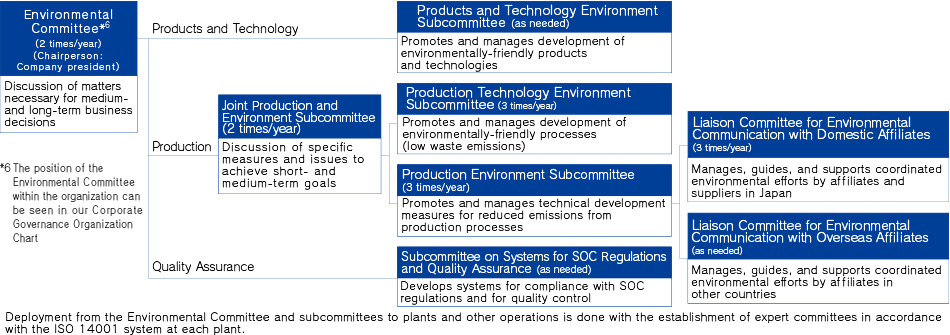
Risk and opportunity associated with climate change and resource depletion
The risks and opportunities associated with climate change and resource depletion are recognized as an important management issue. We are working to strengthen our responses to the overall financial and social risks from the effects on economic and production activities of more drastic abnormal weather, changing precipitation patterns, droughts and floods, from a global perspective based on laws, regulations and trends.
| Risk | Opportunity | |
|---|---|---|
| Climate change |
Cost increases from carbon tax and soaring energy prices | Development of lighter weight, next-generation automotive parts, cost reductions from efficient energy use |
| Resource depletion |
Effects of water shortages and floods on production activities | Cost reductions from re-use and decreased use of water |
| Cost increases from difficulty in procuring materials, soaring material prices | Cost reductions from recycling technology, use of fewer materials | |
| Management (regulatory compliance) |
Loss of trust in the company due to environmental problems, including legal violations, and insufficient efforts to protect the environment | Raise brand strength by enhancing environmental activities |
Resource utilization and environmental emissions in business activities
To lessen the amount of energy, material and other resource inputs, and maximum product output, we are utilizing our skills in product development, process development and workplace kaizen in efforts to improve through business activities.
The input resources we use include environmentally friendly materials and clean energy.
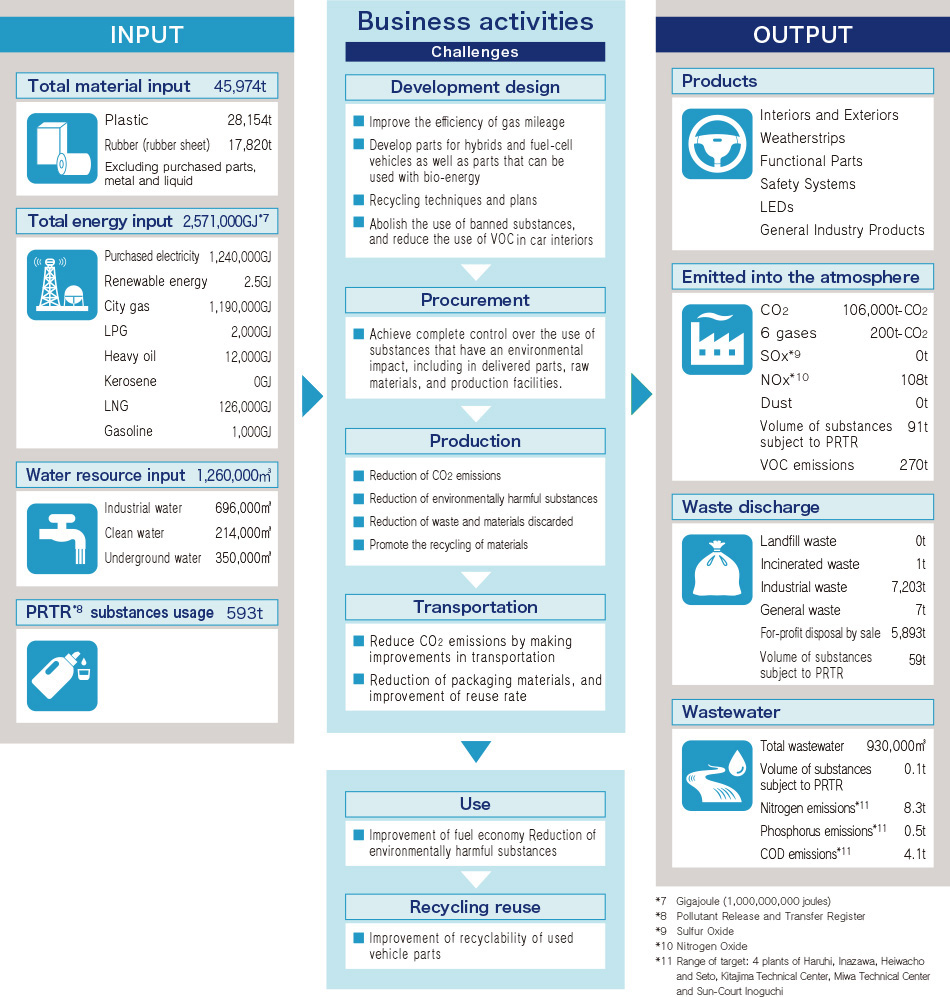
Environmental impact in the value chain
From the perspective of preserving the earth, we have surveyed and disclosed not only GHG emissions (Scope 1*12 , Scope 2*13 ) in our business activities but also emissions in our entire value chain including excavation of raw materials and product use and disposal (Scope 3*14 ). To increase precision for a more accurate picture, we reviewed the calculation method and data collection for Scope 3.
- *12 Greenhouse gas emissions emitted directly by the company itself (natural gas and other fossil fuels, etc.)
- *13 Indirectly emitted greenhouse gases (electricity, etc.)
- *14 Greenhouse gases emitted in the supply chain that are indirectly emitted by the company (manufacturing, transport, business travel, commuting, etc.)
■CO2 emissions by scope level
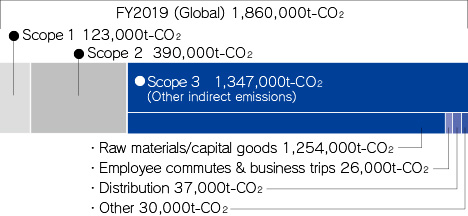
Environmental Protection Costs
Toyoda Gosei accurately monitors costs incurred for environmental protection in our business endeavors, and conducts appropriate environmental protection activities.
In Toyoda Gosei’s FY2019 environmental protection costs, priority is placed on research and development, business areas (switch to LEDs for high-ceiling lighting, recycling, greenhouse gas reductions), and social activities (Plant Afforestation). The economic effects include reduced waste disposal costs with measures to reduce waste production and increase waste recycling, thorough daily kaizen in workplaces, and lower electricity costs with increased efficiency in utility equipment.
■Environmental Protection Costs
(Unit: \100 million)
| Type of cost | Toyoda Gosei | Affiliates in Japan, total |
|---|---|---|
| Research and development costs*15 | 14.4 | 0 |
| Costs within business areas*16 | 21.4 | 3.1 |
| Management activity costs*17 | 2.0 | 0.4 |
| Social activity costs*18 | 0.7 | 0.03 |
| Environmental damage costs*19 | 0.2 | 0 |
| Total | 38.7 | 3.5 |
- *15 Costs for research and development of products that reduce environmental impact
- *16 Costs to reduce environmental impacts from production, including pollution control, reduced energy consumption, and waste disposal.
- *17 Costs for management, including education, maintenance of the environmental management system, and measurements.
- *18 Costs for such measures as tree-planting and beautification.
- *19 Costs for dealing with environmental impacts from business operations.
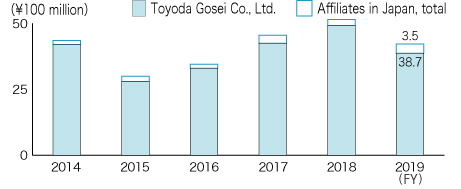
■Economic effect*20
(Unit: \100 million)
| Item | Toyoda Gosei | Affiliates in Japan, total |
|---|---|---|
| Energy expenses | 1.7 | 0.3 |
| Waste-processing expenses | 2.4 | 0.1 |
| Total | 4.1 | 0.4 |
- *20 The economic effects calculated here are those that can be ascertained based on solid evidence.
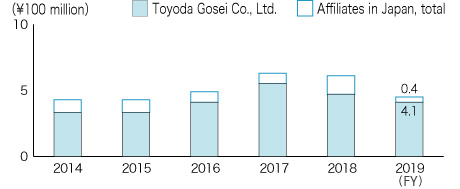
■Quantitative effect*21
| Item | Effect |
|---|---|
| Global warming prevention (CO2 reduction) | 5,904t-CO2 |
| Waste reductions (amount reduced) | 1,167t |
| Legal compliance |
- *21 Amounts are calculated for Toyoda Gosei alone.
Environmental Data
- Contributing to Environmental Preservation Through All Our Business Activities
- Sixth Environmental Action Plan Activities and Results
- Building a decarbonized society
- Building Recycling Societies
- Environmental Preservation and Building Environmentally-Friendly Societies
- Environmental Management
- Environmental Efforts at Affiliated Companies
- Environmental Data
- Third-Party Verification
- TCFD Index
- Third-Party Assessment